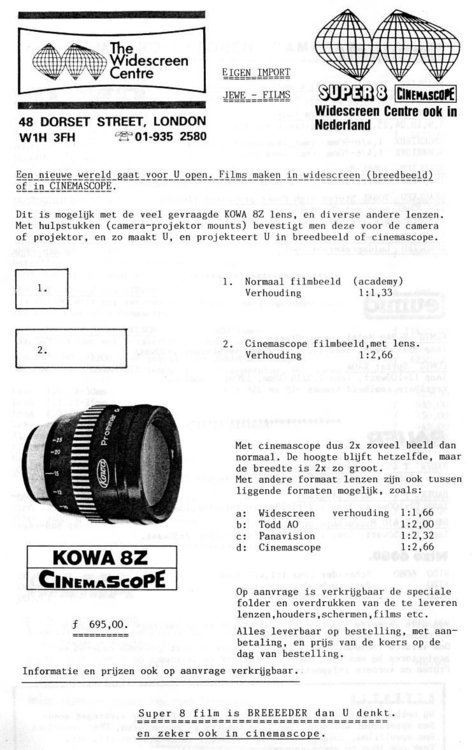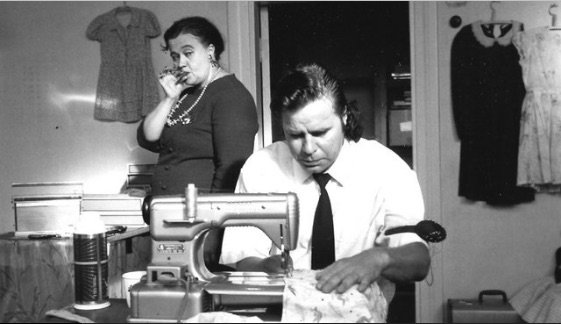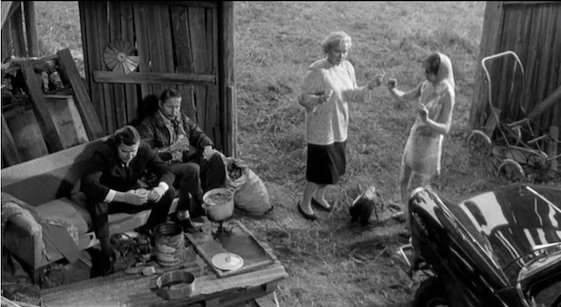
Emiel de Jong
Basic Member-
Posts
22 -
Joined
-
Last visited
Everything posted by Emiel de Jong
-
Haha, congratulations! And your procrastination habits are about the healthiest I've seen... ?
-
Postproduction guidance - beginner
Emiel de Jong replied to Patricia Dauder's topic in Post Production
Apart from that 4000 page manual (you need lots of courage for that as a starter...) there are also some much more friendly training books on https://www.blackmagicdesign.com/products/davinciresolve/training . Download is free and you get all media material with it to start working with Resolve immediately. The books are a beginner's guide, and then more detailed guides for editing, audio, color correction and visual effects. I think they are pure fun! -
The 8Z adapter for my super-8 camera... something I had to have when a Dutch dealer in the early 1990's made it available. It was fun, but results were always a bit soft in my experience. Later, when I got into film projection professionally, I always felt that this was just the 16H 16mm projection anamorphic with a different name on it to sell it to the super8 filmmaker. On YT there are a few videos that compare the 8Z and the 16H, differences in sharpness are found, but I still guess this has to do with the calibration of the individual lenses instead of being the result of a different design. They simply look too exactly the same ? A YT video shows they come with either blueish or yellowish coating, and that makes a difference for sure in lens flare color. I once encountered the same lens also as part of a cheaper 35mm film projection combination: a quick google shows this must have been the "Sankor Anamo-Prime". I think too the professional anamorphic taking lenses from Kowa must have been completely different things...
-
-
-
Ektachrome 100 is BACK!!
Emiel de Jong replied to Nick Collingwood's topic in Film Stocks & Processing
About direct prints from Vision 3 50D: 2 years ago I shot some tests with it and we had it printed, it became clear that the effect I wanted, outspoken colors and rich blacks, was simply not possible. (And I wasn't going for the Kodachrome type of outspoken colors, just the effect I got automatically with negative / positive some ten years earlier.) Somebody from the lab here in the Netherlands explained to me: Vision 3 is designed for digital intermediate, has therefore soft colors, and print film to compensate for that surely existed (if I remember correctly he mentioned some Fuji stock), but is not made anymore. This was 35mm but I guess print film stock availability is the same for 35 and 16.- 89 replies
-
- super 8
- ektachrome
-
(and 3 more)
Tagged with:
-
Labs in Europe - Recommendations?
Emiel de Jong replied to Alexander Boyd's topic in Post Production
I was very happy with the services of Dejonghe and also with those of the not yet mentioned lab in Amsterdam: http://www.haghefilm-digitaal.nl -
Ektachrome 100 is BACK!!
Emiel de Jong replied to Nick Collingwood's topic in Film Stocks & Processing
This article mentions "feature films shot with..." and "35mm": http://nofilmschool.com/2017/01/kodak-ektachrome-35mm I am wondering too: will it be available in 35mm, and with negative or positive perforation?- 89 replies
-
- super 8
- ektachrome
-
(and 3 more)
Tagged with:
-
Lowel Quartz D safety question
Emiel de Jong replied to Emiel de Jong's topic in Lighting for Film & Video
Thanks Don. I will get those screens... -
I got some nice Lowel Quartz D sets ( the yellow ones). They don't have protective screens: were those only introduced with the later DP model, or are they just missing? And should it be possible to use the DP ones on the D model? Thanks...
-
Increase contrast photochemically (contact printing)
Emiel de Jong replied to Ben Brahem Ziryab's topic in Post Production
Thanks Kenny, that's excellent; if it's up to me that's exactly what we will do next time. I will check out his other articles too... -
Increase contrast photochemically (contact printing)
Emiel de Jong replied to Ben Brahem Ziryab's topic in Post Production
Thanks David, that is all very valuable information. If we do another project all-analog there will be some heavy testing before, and then I want to bring in people anyway who are more skilled in this field than I am myself. I love the idea of working with film and film only, but if if the qualities I associate with that cannot be produced anymore with the materials available right now it would be mad to refuse digital finishing. (So, we "were" in the same festival in Amsterdam ! I couldn't be there the day "The Love Witch" played, so unfortunately I have not seen it yet.) -
Increase contrast photochemically (contact printing)
Emiel de Jong replied to Ben Brahem Ziryab's topic in Post Production
"Unless the timer took you into his hazeltine room for a pass before the 1st answer print, which is unusual." - Yes, this was exactly what happened, except it was a Colormaster. Second session was with the answer print, looking at it directly through a magnifying glass and through different color filters. -
Increase contrast photochemically (contact printing)
Emiel de Jong replied to Ben Brahem Ziryab's topic in Post Production
Kenny, I don't know... (as you will guess I am not a DOP and this is not something I do every day, I hope you all appreciate that I try to learn about it though...). I remember a conversation I had with the grader when I asked about the negative, he considered it fairly normal. What I did at the first session was asking for a less bright image till I sort of liked what was on the monitor screen, this produced a print which was in parts somewhat too dark, without giving in return the extra saturation and deep blacks I was expecting to get. -
Increase contrast photochemically (contact printing)
Emiel de Jong replied to Ben Brahem Ziryab's topic in Post Production
I guess I ran into the same problem lately: for me it was the first time I used Vision 3 50D (and film again in general for the first time in about 10 years) and what I did not expect in the direct print was the "softness" of the colors: I like the more saturated and hard colors with deep blacks I was used to. I learned from somebody at the lab that Vision 3 is designed with DI in mind, that Fuji in their last years of producing motion picture film had a special print stock designed that could increase contrast and saturation from these "softer" working negatives, but that nowadays this is simply not possible anymore, in an analog way. Now, if you still want to finish all-analog and if you still want that look like 1990's prints often had (I hope you will forgive this vague and subjective description) do you think it can be brought back if you experiment enough with these sort of "tricks"? Or is the only real hope some manufacturer brings back an "old-fashioned" working film stock (I am thinking of the restarting Ferrania company in Italy maybe)? -
For those interested in what happened further: after some advice from experienced people I ended up flattening the slightly grooved metal discs on an optical flat, and roughing up the surface very slightly. This made the slip clutch perform in the right way, becoming really hot though. For our small shoot (test and actual: just some 600 ft. ...) this worked, but I did put some oil on the discs again to prevent high temperature. If we use this camera again I will have it properly and professionally serviced first. In the meantime our short "The Creature From Under the Bridge" was shown at the Amsterdamned 2016 Filmfestival http://amsterdamnedfilmfestival.nl/#shorts We had the negative cut at HaghefilmDigitaal, check out their facebook page: there are some nice photos on it of the actual splicing. For me it was the first time I used Vision 3 (and film again in general for the first time in about 10 years) and what I did not expect was the "softness" of the colors: I like the more saturated and hard colors with deep blacks I was used to, something-as I understood- is not possible anymore, all analog, with the print film available right now. I am looking forward to everyone's thoughts on this, though maybe it doesn't really belong in this topic.
-
Tyler, after re-assembly, I started with much lower pressure on the assembly than it was set to, but that does not guarantee that there was not something wrong of course. When you set the pressure really low those discs still come apart( you can see the side of the assembly when you open the door for the "inverted" 400 ft. magazine at the back of the camera). And yes, I hope not, but it could very well be that too much material wore away. At least not to the surface of the 3 metal pins with which each black disc is attached to the side of the gear...
-
Mark, yes, the discs could well be bakelite, they look like it, this camera is from the late '60-s I guess. Gregg, exactly, and in this case one of the gears is not fixed on its shaft, instead it is between 2 friction discs which are connected to that shaft. A spring presses this assembly together, you can adjust this pressure with a thumbscrew. I am not familiar with the older Mitchells (wouldn't mind to correct that though...;-) but since the magazines are interchangeable between the S35R and the older models I guess the way the slipage works should be the same.
-
On the feed sides of the magazines there are brakes indeed. For the take-up there is an adjustable friction built into the camera itself: it's a gear between two discs. This brings me to another question I only thought of now: the belt driving the magazine isn't supposed to slip is it? The old leather belts with the camera are shrunken and unusable, so I made new ones from 3mm diameter "ropanyl" (the green stuff you can weld yourself for every size of belt). This material is definitely not slipping easily.
-
Thanks Mark, I thought the same. However since I don't know which material the central discs are made of (black plastic-like) I am hesitating.
-
I am bringing a Mitchell S35R (or Mark II...) back to life for a short test: all seems to work perfectly except for the take-up friction, which is pulling the film way too hard. Loosening the set screw didn't solve the problem: a sort of all or nothing effect. So I have cleaned the discs which were indeed really dirty. Now my question is: should I oil or grease these discs? I hope somebody can help... (and yes I know, the best for this camera would be to have it properly serviced, but that is out of the question for now, and here, in the Netherlands...)






